
|
Mother Pelican
A Journal of Solidarity and Sustainability
Vol. 10, No. 9, September 2014
Luis T. Gutiérrez, Editor
|
|
|
|

|
|
|
|
Strategies for Solidarity and Sustainability
|
|
SUMMARY & OUTLINE
This page attempts to provide a synthesis of principles and strategies for the transition to a world of solidarity and sustainability.
1. Primacy of Integral Human Development
2. Joint Integrity of Humanity and the Human Habitat
3. Mitigation of Habitat Degradation & Climate Change
4. Adaptation to Habitat Degradation & Climate Change
5. Solidarity, Subsidiarity, Sustainability, and Nonviolence
6. Non-Renewable & Renewable Energy Resources
7. Simulation Scenarios of the Transition to Sustainability
8. Variations of the Integrated Transition Strategy
9. Strategic Data Sources & Global Transition Megatrends
|
The key working hypothesis is that the transition from consumerism to sustainability will revolve around the transition from fossil fuels to clean energy, and this transition will come to pass whether we like it or not. However, the amount of human suffering during this process will depend on human adaptability and social cohesion. The simulations are not meant to be predictive but to show a range of plausible scenarios.
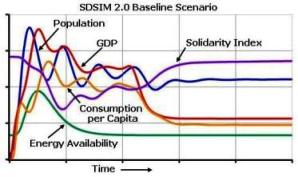 Solidarity reinforces Sustainability and vice versa
Solidarity reinforces Sustainability and vice versa
|
The horizontal and vertical scales are not shown in order to avoid giving the impression that this is a prediction. This is a simulated scenario, not a prediction. It portrays dynamic modes of system behavior that can be expected during the transition from consumerism to sustainability, as follows:
~ Population, production, and consumption peak, stagnate and/or oscillate with downward trend, and eventually decrease to long-term sustainable levels.
~ The peak in energy availability is followed by a long decline until it settles to the steady-state flow that is allowed by solar (and perhaps other cosmic) sources of energy.
~ The solidarity index is an indicator of social cohesion, which is tightly coupled with the sustainability of resource usage.
This is not intended to be an "alarmist" scenario. However, it would be wise to take the Precautionary Principle into account when formulation sustainable development policies as we enter the Anthropocene Age. Widespread violence is bound to emerge if demographic and consumption adjustments are to be made involuntarily. Is this "the future we want" for the entire community of nations? NB: The current SDSIM 2.0 is a demo, not a capability.
SEE SECTION 7 FOR A SUMMARY OF WORK IN PROGRESS
|
|
|
1. Primacy of Integral Human Development
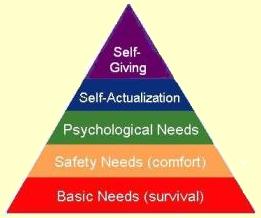
Maslow's Hierarchy of Human Needs
Adapted from The Cell
|
As a matter of principle, any strategy for the transition to clean energy must recognize integral human development as the most fundamental requirement to guide both public and private initiatives. Integral human development builds on respect for human rights and diligence on human duties, both individually and institutionally. A fundamental document is The Universal Declaration of Human Rights, approved by the United Nations General Assembly on 10 December 1948.
Hierarchy of Human Needs
Abraham Maslow (USA, 1908-1970) created the "hierarchy of human needs" in the 1940s. Maslow's model explicitly takes into account the physiological, safety, emotional, love/belonging, esteem/self-esteem, and self-actualization stages of integral human development. The hierarchy of human needs is usually represented as a pyramid, with the most basic needs at the bottom and the socialization needs at the top. There are many variations of the pyramid: one is shown to the right and others can be easily found. Going upward, the progression for each human being is to satisfy (1) the basic physical and physiological needs, (2) the need for safety and security, (3) the need psychological well-being, (4) the need for self-actualization (self-esteem, social responsibility), and (5) self-giving to others, or at least the desire to seek the common good in conjunction with legitimate self-interest. For further discussion of Maslow's "levels of human development" - and other models of human development - the reader is referred to the May 2010 issue of Mother Pelican. Attaining a culture of solidarity and sustainability is practically impossible under level 3, and generally requires level 4. This means that enabling people "to live to their full potential" requires, beyond meeting basic physical needs, access to educational and job opportunities as well as freedom for each person follow their "vocation" in life under conditions of human solidarity, social justice, and ecological sustainability. The following article, contributed by Steven Salmony, is about the feasibility of providing such opportunities in the context of current population growth trends.
UN HUMAN DEVELOPMENT REPORT 2014
|
RELATED PUBLICATIONS
Measuring Human Progress in the 21st Century, Khalid Malik, UNDP, 19 March 2014.
Social Values, Employment and Human Development: Beyond Economic Utilitarianism, Andrew Fischer, UNDP, 20 May 2014.
The Evaluation of the Sustainable Human Development: A Cross-country Analysis Employing Slack-based Data Envelopment Analysis, Supachet Chansarn, Procedia Environmental Sciences, Volume 20, May 2014.
|
|
2. Joint Integrity of Humanity and the Human Habitat
|
Human development cannot happen in a vacuum. Therefore, maintaining the integrity of the human habitat is essential for sustainable human development. One fundamental document is The Earth Charter, approved by the Earth Charter Commission 29 June 2000 after 5 years of preparation and worldwide consultation. Another fundamental document is the annual Human Development Report of the United Nations, in which the Human Development Index (HDI) is correlated with Ecological Footprint data on a country by country basis, showing that "only a few countries come close to creating such a globally reproducible high level of human development without exerting unsustainable pressure on the planet’s ecological resources."
There is an emerging consensus that climate change has become the central issue of human habitat desintegration.
HUMANITY AND THE HUMAN HABITAT
ENVIRONMENT & EVOLUTION
Environment Speeds Evolutionary Change, Rosanne Skirble, Voice of America, 12 April 2013.
Excerpt: "A new study challenges the widely held belief that evolutionary changes in living organisms take place slowly, over hundreds, thousands or millions of years. Researchers have found evidence species can evolve much more quickly when in response to environmental change." For more information, see Ecology Letters and the website of Tim Benton, Cambridge University, UK.
Milestones of Human Evolution from Paleontology & Bioinformatics, Bosco Ho, May 2014
Excerpt: "Although numerous hypotheses have been proposed over the last century and a half since Darwin to explain the origin of human traits, no one hypothesis has really suceeded, largely because of the lack of direct evidence for any of these hypotheses. However, things have changed over the last few decades. Enough paleontological and, more suprisingly, bioinformatic discoveries have accumulated to determine a reasonably reliable chronological order in which our ancestors gained each of these human traits."
|
NATIONAL & GLOBAL CLIMATE CHANGE ASSESSMENTS
|
LINKS TO RECENT REPORTS & ARTICLES ON CLIMATE CHANGE
Summary of the 12th Session of Working Group I of the Intergovernmental Panel on Climate Change (IPCC) and 36th Session of the IPCC, IISD, 23-26 September 2013
Climate Change 2013: The Physical Science Basis, Fifth United Nations Intergovernmental Panel on Climate Change (IPCC) Report, AR5, WG1, 27 September 2013
SUMMARY REPORT
FULL REPORT
Climate Change 2013: Summary for Policymakers, IPCC WG1 AR5 Report, 27 September 2013
U.N. Climate Panel Endorses Ceiling on Global Emissions, Justing Gillis, New York Times, 27 September 2013
IPCC report: The financial markets are the only hope in the race to stop global warming, Tom Bawden, The Independent, 27 september 2013
The New IPCC AR5 Report: How Should Leaders Respond?, David Thorpe, The Energy Collective, 27 September 2013
Research Behind the Headlines: The IPCC AR5 Report, Harriet Jarlett, Planet Earth, 27 September 2013
Human Influence On Climate Clear, IPCC Report Says, Science Daily, 27 September 2013
Alarming IPCC Prognosis: 9°F Warming For U.S., Faster Sea Rise, More Extreme Weather, Permafrost Collapse, Joe Romm, Climate Progress, 27 September 2013
Climate Panel’s Fifth Report Clarifies Humanity’s Choices, and Why More Climate Science Hasn’t Led to More Climate Policy – Yet, Andrew Revkin, Dot Earth, 27 September 2013
IPCC diagnosis – permanent paradigm paralysis, Judith Curry, Climate Etc., 28 September 2013
Climate Change: It’s Real, and It’s Us, Phil Plait, Slate, 30 September 2013
Climate Science and the Uncertaintly Monster, Judith Curry & Peter Webster, Bulletin of the American Meteorological Society, September 2013
Breaking the Cycle of Climate Inaction, Jonathan Foley, ENSIA, 1 October 2013
The IPCC has spoken. Now what?, Oliver Tickell, The Ecologist, 2 October 2013
What Does the New IPCC Report Say About Climate Change?, Steve Easterbrook, Serendipity, 8 October 2013
A Physicist Reflects on the Climate Debate, Pierre Darriulat, Climate Etc., 12 October 2013
Climate Change Reconsidered II: Physical Science (CCR-II), Nongovernmental International Panel on Climate Change (NIPCC), 17 September 2013
Global Warming Controversy: a Trojan Horse of Modernity, Lionel Scotto D'apollonia, Science in Society, October 2013
The Geography of Poverty, Disasters and Climate Extremes in 2030, Overseas Development Institute (ODI), UK, 17 October 2013
Chemistry's climate of scepticism, Philip Ball, Chemistry World, 21 October 2013
Liberal denial on climate change and energy, Judith Curry, Climate Etc., 24 October 2013
IPCC’s ‘Carbon Budget’ Will Not Drive Climate Talks, Fiona Harvey, Climate central, 26 October 2013
Implications for climate models of their disagreement with observations, Judith Curry, Climate Etc., 30 October 2013
Workshop on the Roles of Climate Models, Judith Curry, Climate Etc., 31 October 2013
Greenhouse Gas Concentrations in Atmosphere Reach New Record, Greenhouse Gas Bulletin, WMO, 6 November 2013
Climate Change 2013: The Physical Science Basis, Fifth United Nations Intergovernmental Panel on Climate Change (IPCC) Report, AR5, WG1, 11 November 2013
FINAL SUMMARY REPORT
Rich vs. poor: Divide deepens over who should pay for climate change, Nina Chestney, Reuters, 20 November 2013
Man-Made Climate Change Mostly Due To Just 90 Companies, Suzanne Goldenberg, The Guardian, 20 November 2013
Social cost of carbon, Judith Curry, Climate Etc., 21 November 2013
Social cost of carbon - Part II, Judith Curry, Climate Etc., 27 November 2013
A Factual Look at the Relationship Between Climate and Weather, Judith Curry, Climate Etc., 11 December 2013
IPCC Working Group III submits climate change mitigation report for final review, IPCC, 17 December 2013
It won't be long before the victims of climate change make the west pay, Chris Huhne, The Guardian, 29 December 2013
Climate change by the numbers: The worst is yet to come, Lindsay Abrams, Salon, 29 December 2013
IPCC AR5 weakens the case for Anthropogenic Gobal Warming (AGW), Judith Curry, Climate Etc., 6 January 2014
Hawaii lab finds big nitrogen leap in Pacific due to climate change, Staff, Science Blog, 9 January 2014. Based on HURL enables discovery of dramatic long-term shift in Pacific ecosystem, Chris Kelley and Marcie Grabowski, University of Hawaii at Manoa, 8 January 2014
The Big Question: Is global warming caused by humans?, Dagfinn Reiersøl, Climate Etc., 29 January 2014
Harnessing Ecosystem-based Adaptation To Address the Social Dimensions of Climate Change, Richard Munang, Jesica Andrews, Keith Alverson, and Desta Mebratu, Environment: Science and Policy for Sustainable Development, January-February 2014
Berkeley Earth Global: Data and Analysis Update, Steve Mosher, Climate Etc., 25 February 2014
Climate Change: Evidence & Causes, Royal Society and US National Academy of Sciences, 27 February 2014
New Study Yanks Away Glimmer of Hope on Climate Change, Chris Clarke, KCET, 9 March 2014
What We Know: The Reality, Risks, and Response to Climate Change, AAAS, March 2014
Scientists: Wake Up, America! US Climate Inaction Imperils Earth, Jon Queally, Common Dreams, 18 March 2014
We Can’t Just Geoengineer Our Way Out of Climate Change, David Suzuki, Common Dreams, 19 March 2014
New UN Report Is Cautious On Making Climate Predictions, Fred Pearce, Yale e360, 24 March 2014
Climate change: the debate is about to change radically, Andrew Lilico, The Telegraph, 25 March 2014
IPCC report: climate change felt 'on all continents and across the oceans', Suzanne Goldenberg, The Guardian, 28 March 2014
Climate Change 2014: Impacts, Adaptation, and Vulnerability, Press Release, IPCC, 31 March 2014
Climate Change 2014: Impacts, Adaptation, and Vulnerability, Summary for Policy Makers, IPCC, 31 March 2014
New Climate Change Report Warns of Dire Consequences, Brian Clark Howard, National Geographic, 31 March 2014
Tail Risk vs. Alarmism, Kerry Emanuel, Climate Change Natural Forum, 31 March 2014
Evidence of absence versus absence of evidence, Judith Curry, Climate Etc., 1 April 2014
The UN's New Focus: Surviving, Not Stopping, Climate Change, Uri Friedman and Svati Narula, The Atlantic, 1 April 2014
Climate Change in the Balance, Yokohama Report, The Economist, 5 April 2014
Rough Forecasts, Elizabeth Kolbert, The New Yorker, 14 April 2014
Scaling fluctuation analysis and statistical hypothesis testing of anthropogenic warming, Shaun Lovejoy, Climate Dynamics, 6 April 2014
Climate Change 2014: Mitigation of Climate Change, IPCC AR5 WG3, 11 April 2014
Forest Climate and Condensation,
Douglas Sheil, Climate Etc., 15 April 2014
IPCC Report Flawed By Narrow Focus on Carbon Emissions, Subhankar Banerjee and Joshua Howe, Common Dreams, 15 April 2014
The Science And Politics Of Climate Change, Lennart Bengtsson, GWPF, 15 April 2014
Worst case scenario versus fat tail, Judith Curry, Climate Etc., 18 April 2014
Coal and the IPCC, David Rutledge, Climate Etc., 22 April 2014
An alternative metric to assess global warming, Roger A. Pielke Sr., Richard T. McNider, and John Christy, Climate Etc., 28 April 2014
The Climate Crisis, Editorial, America, 1 May 2014
Climate Change Impacts in the United States: The Third National Climate Assessment, US-GCRP, 6 May 2014
Are climate scientists being forced to toe the line?, Judith Curry, Climate Etc., 24 May 2014
The heart of the climate dynamics debate, Judith Curry, Climate Etc., 26 May 2014
Globe Hits Greenhouse Pollution Landmark, Julian Hattem, The Hill, 26 May 2014
IPCC WG2 AR5 FINAL REPORT, Summary for Policymakers, IPCC, with Erratum, 3 June 2014
Agreeing on Robust Decisions: New processes for decision making under deep uncertainty, World Bank, June 2014
Jane Goodall: Governments Must Challenge Fossil Fuel Corporations, Primatologist stresses need for urgent climate, conservation action, Andrea Germanos, Common Dreams, 2 June 2014
Complexity of Politics in Climate Compatible Development: Creating wins over space and time, T. Tanner, IDS, 10 June 2014
The Coming Climate Crash: Lessons for Climate Change in the 2008 Recession, Henry M. Paulson Jr., 21 June 2014
The IPCC and treatment of uncertainties: topics and sources of dissensus, Carolina Adler and Gertrude Hirsch Hadorn, WIREs Climate Change, 7 July 2014
A New Market-Based Climate Solution Achieving 2°C and Equity,
Mutsuyoshi Nishimura, Energy & Environment, 23 July 2014
Politicizing the IPCC Report, Judith Curry, Climate Etc., 29 July 2014
MIT Study Predicts Global Climate Deal Will Fail to Reach Warming Target, Ben Geman, National Journal, 6 August 2014
Expectations for a New Climate Agreement, Henry D. Jacoby and Y. H. Henry Chen, MIT Global Change Research Program, August 2014
WHO: Climate change major threat to human health, Adrien Taylor, 3 News NZ, 31 August 2014
Thermodynamics, Kinetics and Microphysics of Clouds, Judith Curry, Climate Etc., 4 September 2014
The State of Greenhouse Gases in the Atmosphere Based on Global Observations through 2013, WMO, 10 September 2014
|
UNITED NATIONS
Intergovernmental Panel on Climate Change (IPCC),
Fifth Assessment Report (AR5),
Summary for Policymakers (Final), 3 June 2014
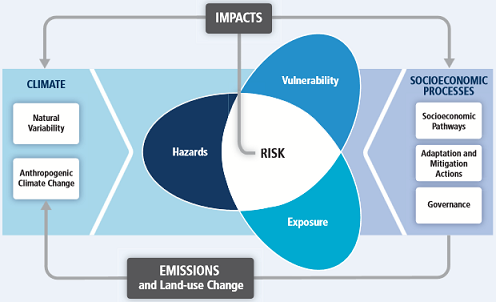
"Illustration of the core concepts of the WG2 AR5. Risks of climate-related impacts results from the interaction of climate-related hazards (including hazardous events and trends) with the vulnerability and exposure of human and natural systems. Changes in both the climate system (left) and socioeconomic processes including adaptation and mitigation (right) are drivers of hazards, exposure, and vulnerability."
|
|
3. Mitigation of Habitat Degradation & Climate Change
|
There are two broad sets of strategies to ensure the long-term sustainability of the human habitat: mitigation and adaptation. As currently formulated in a globally patriarchal context, neither one assures a civilized transition from consumerism to sustainability. Such a transition becomes feasible if, and only if, there is a confluence of energy balance and gender balance. Energy balance, and a shift from fossil fuels to clean energy, is indispensable. The other indispensable catalyst is the transition from patriarchal domination to cross-gender solidarity.
Mitigation Strategies
In general, mitigation strategies attempt to minimize the risks associated with an impending threat. Ecologically, mitigation strategies attempt to reduce the rate of natural resource depletion and other negative impacts of economic activity on the human habitat. There are many kinds of mitigation strategies depending on culture, geography, the nature of the threat, vulnerability to a given threat, and the human/habitat resources to be protected from a given threat.
The following are links to online resources on mitigation strategies:
All mitigation strategies entail a tradeoff between economic growth and the ecology of the planet:
Weaning From Fossil Fuels and Growing a Green Economy, Dennis Posadas, YaleGlobal, 8 March 2013
"Innovation in renewable energies is taking many directions, though implementation of best practices and policies is naturally slow to follow. It may be unrealistic to expect a global treaty on climate before innovation plays out. “Worldwide implementation may require getting comfortable with many different culturally appropriate approaches,” writes Dennis Posadas, author and fellow of the Climate Institute. “There are many ways to encourage carbon mitigation, but perhaps no single panacea.” Cost comparisons of renewables with fossil fuels are unfair as long as the latter receives the lion’s share of subsidies – by one report, the wealthiest countries pay five times as much in subsides for fossil fuels than they do for climate aid. Coal may appear as the least expensive source of energy as long as many governments disregard health and environmental costs. Individual countries and cities are developing an array of programs for climate protection, including carbon taxes – a good backup plan until the world reaches agreement on a fair and effective climate treaty." – YaleGlobal
|
|
4. Adaptation to Habitat Degradation & Climate Change
|
As already mentioned in the previous section, there are two broad sets of strategies to ensure the long-term sustainability of the human habitat: mitigation and adaptation. Most probably, attaining global energy balance will require significant adaptation of human behavior in conjunction with radical economic reforms. Such behavioral adaptation and structural reforms are contingent on gender balance and integral human development. As currently formulated in a patriarchal context, neither one assures a civilized transition from consumerism to sustainability. Such a transition becomes feasible if, and only if, there is a confluence of energy balance and gender balance. Energy balance, and a shift from fossil fuels to clean energy, is indispensable. The other indispensable catalyst is the transition from patriarchal domination to cross-gender solidarity.
Adaptation Strategies
Adaptation strategies attempt to reverse environmental degradation by changing patterns of human behavior regarding production and consumption of goods and services.
The following are links to online resources on adaptation strategies:
- Economic and Technological Transition from Fossil Fuels to Energy Balance
- United Nations - Millennium Development Goals (2015 goals in jeopardy)
- UNDP - Human Development Reports 1995-2011
- Sustainable Consumption and Production Strategies
- United Nations - National Sustainable Development Strategies
- European Union National Adaptation Strategies
- IISD National Sustainable Development Strategies
- IIED Strategies for Sustainable Development
- Hatching Capabilities for Sustainable Development in New Zealand
- The Human Dimension of Climate Adaptation
-
Technologies for Climate Change Adaptation in the Agriculture Sector
- Climate Change Adaptation in Developed Nations
- Climate Change and Industrial Policy
- IPCC - Adaptation to Climate Change in the Context of Sustainable Development and Equity
- Global Energy Governance in a Fragmented World
- Climate Change Vulnerability, Impacts and Adaptation
- UNDP - Adaptation to Climate Change in Poverty Reduction Strategies
- Planning and Preparing for Post Peak Life
- Decision Making in a Changing Climate—Adaptation Challenges and Choices
- Private Sector Engagement in Adaptation to Climate Change: Approaches to Managing Climate Risks, Shardul Agrawala et al, OECD Environment Working Papers, 30 November 2011
- Monitoring and Evaluation for Adaptation: Lessons from Development Co-operation Agencies, Nicolina Lamhauge, Elisa Lanzi, Shardul Agrawala, OECD Environment Working Papers, 28 November 2011
- Report of the Interagency Climate Change Adaptation Task Force: Federal Actions for a Climate Resilient Nation, White House Council on Environmental Quality, 28 October 2011
- The energetic society. In search of a governance philosophy for a clean economy, Maarten Hajer, PBL Netherlands Environmental Assessment Agency, 6 October 2011
- Climate Change Adaptation in Europe, European Environment Agency (EEA), March 2012.
- Gross National Happiness vs. Gross Domestic Product, Andrew Billo, Asia Society, 5 April 2012.
- Toward a Separation of Oil and State, Eric Anderson, Worldwatch Institute, 13 April 2012.
-
Adaptation Field Guide Issue, Tim Magee, CBA Climate Adaptation News, 19 April 2012.
- Coastal Land Loss and the Mitigation-Adaptation Dilemma: Between Scylla and Charybdis, Blake Hudson, Lousiana Law Review, 14 June 2012.
- World Bank Focuses on Climate Change in Hunt For Fresh Strategy, Sandrine Rastello, Bloomberg, 10 January 2013.
- Agencies Release Sustainability Plans, Include Climate Change Adaptation, Environment Reporter, Bloomberg, 8 February 2013.
Both mitigation and adaptation strategies have a role to play in attaining the transition to sustainability. But assuring the effectiveness of mitigation and adaptation strategies will require a radical upgrade in the quality of human relations, and this in turn will require a cultural transition from patriarchy to solidarity. This cultural transition has already started, but it may take a long time to run its course as it entails overcoming 5000+ years old bad mental habits. The transition from fossil fuels to clean energy may take a few decades but it is a matter of overcoming habits that are only 300 years old. Hopefully, increasingly pressing ecological issues and constraints will trigger human awareness and motivation to the point of enabling both transitions to unfold simultaneously and before it is too late. The following article is a good example of mitigation-adaptation tradeoffs:
|
Excerpt: "A global goal for limiting climate change is slipping out of reach and governments may have to find ways to artificially suck greenhouse gases from the air if they fail to make deep cuts in rising emissions by 2030, according to a 25-page draft report by Working Group Three of the United Nations Intergovernmental Panel on Climate Change. The report, due for publication in 2014, said emissions of heat-trapping gases rose to record levels in the decade to 2010, led by Asian industrial growth. The surge is jeopardizing a U.N. goal, set by almost 200 nations in 2010, to limit a rise in temperatures to below 2 degrees Celsius above levels before the Industrial Revolution. Temperatures are already 0.8 C above pre-industrial levels and creeping higher. Most climate experts say the rising trend will pick up in coming years. If emissions were not checked by 2030, they would be so great that governments would have to take carbon dioxide out of the air to limit rising temperatures by the end of the century - not just cut emissions spewed from cars and factories - a sea change in the approach to climate change."
|
|
Excerpt: "Newly released data revealed continued growth in emissions of atmospheric carbon dioxide and other major greenhouse gases, as well as a shifting geographic distribution of emissions. According to the Global Carbon Project, CO2 emissions from fossil fuel combustion and cement production reached 9.7 gigatons of carbon in 2012, with a ±5 percent uncertainty range. This is the highest annual total to date—and it is 58 percent higher than emissions in 1990, the year often used as a benchmark for emissions trends. Coal (43 percent) and oil (33 percent) accounted for the majority of these emissions, with natural gas (18 percent), cement production (5 percent), and flaring (1 percent) making up the remainder. The Global Carbon Project’s projection for 2013 is 9.9 ± 0.5 GtC, indicating growth of approximately 2 percent."
|
|
5. Solidarity, Subsidiarity, Sustainability, and Nonviolence
|
Transitioning from consumerism to sustainability will require shifting gears in many significant ways. The following principles will be instrumental in attaining the transition to clean energy.
KEY PRINCIPLES
|
PRINCIPLE OF SOLIDARITY
"Solidarity is not a matter of altruism. Solidarity comes from the inability to tolerate the affront to our own integrity of passive or active collaboration in the oppression of others, and from the deep recognition of our most expansive self-interest. From the recognition that, like it or not, our liberation is bound up with that of every other being on the planet, and that politically, spiritually, in our heart of hearts we know anything else is unaffordable."
|
PRINCIPLE OF SUBSIDIARITY
"Subsidiarity is an organizing principle that matters ought to be handled by the smallest, lowest or least centralized competent authority... A central authority should have a subsidiary function, performing only those tasks which cannot be performed effectively at a more immediate or local level... Subsidiarity is, ideally or in principle, one of the features of federalism, where it asserts the rights of the parts over the whole."
| |
PRINCIPLE OF SUSTAINABILITY
"Sustainability is the capacity to endure. In ecology, the word describes how biological systems remain diverse and productive over time. Long-lived and healthy wetlands and forests are examples of sustainable biological systems. For humans, sustainability is the potential for long-term maintenance of well being, which has environmental, economic, and social dimensions."
|
PRINCIPLE OF NONVIOLENCE
"Nonviolence has two (closely related) meanings. (1) It can refer, first, to a general philosophy of abstention from violence because of moral or religious principle (e.g. "She believes in nonviolence.") (2) It can refer to the behaviour of people using nonviolent action (e.g. "The demonstrators maintained their nonviolence.")
|
A shift is needed from consumerism and the profligate use of non-renewable energy resources to moderate use of renewable energy resources. Technologies to develop and deliver clean energy are readily available. But existing technologies, and improved ones to be developed, can make a positive contribution if, and only if, the human side of the equation (as outlined in the preceding sections) is taken care of.
SOLIDARITY, SUBSIDIARITY, AND SUSTAINABILITY IN TODAY'S WORLD

Earth lights. Photo credit: industrial-energy.lbl.gov
|
Looking Back on the Limits of Growth: Forty years after the release of the groundbreaking study, were the concerns about overpopulation and the environment correct?, Mark Strauss, Smithsonian Magazine, April 2012
Energy and Slavery, Guillaume Emin, EcoJesuit, 31 May 2012
America the Posssible - Part 1: From decline to rebirth,
James Gustave Speth, Orion Magazine, March/April 2012
America the Posssible - Part 2: A new politics for a new dream, James Gustave Speth, Orion Magazine, May/June 2012
A Missing Pillar? Challenges in Theorizing and Practicing Social Sustainability, Special Issue: Guest Editor Magnus Boström, SSPP, Winter 2012
Energy and Water Linkage: Challenge to a Sustainable Future, Royal Society UK, 6 June 2012
Those who govern should be required to be eco-literate, Sharon Abercrombie, NCR, 13 June 2012
New report outlines key steps to reduce poverty in a green economy, Michael Oko, Lauren Zelin, Environmental Expert, 13 June 2012
Twenty Years from Now, Gar Alperovitz, New Economics Institute, 19 July 2012
Saving Subsidiarity: Why it is not about small government, Vincent J. Miller, America Magazine, 30 July 2012
A Move Towards More Sustainable Transportation, Worldwatch Institute/Sustainable Prosperity, by Michael Replogle & Colin Hughes, August 7, 2012
Driving a Global Shift to Sustainable Transportation, Michael Replogle and Colin Hughes, CSRwire, 22 August 2012
Renewed global partnership critical for post-2015 development agenda, says UN panel, UN News Center, 27 March 2013
WPP Strategic Action Plan for Phase II (2012-2016), Water Partnership Program, World Bank, July 2013
Catastrophic Shocks in Complex Socio-Economic Systems: A Pandemic Perspective, Phoebe Bright, Feasta, 19 July 2013
Moving Beyond Fossil Fuels Before It’s Too Late, WorldWatch Institute, 23 July 2013
An overview of EU environment policy targets and objectives, EEA, 25 July 2013
Towards a Green Economy in Europe - EU environmental policy targets and objectives 2010-2050, EEA Report, 25 July 2013
Richest countries have 'heads in sand' on global debt, Staff, Ekklesia, 9 September 2013
New Estimate: 30 Million ‘Modern Slaves’ Exploited Worldwide, America, 4 November 2013
Elites Will ‘Consider Inequality’, Ray Smith, IPS, 22 January 2014
THE SOLIDARITY-ENERGY-CLIMATE CONNECTION
Can We Survive the New Golden Age of Oil?, Steve Levine, Foreign Policy, 6 June 2012
Human-induced global ocean warming on multidecadal timescales, P. J. Gleckler et al, Nature Climate Change, 10 June 2012
Study fingers humans for ocean heat rise, Richard Chirgwin, The Register, 11 June 2012
The Battle Over Climate Science, Tom Clynes, Popular Science, 21 June 2012
Global Warming's Terrifying New Math, Bill McKibben, Rolling Stone, 19 July 2012
The Human Factor, Editorial, Nature Climate Change, 27 July 2012
Global Warming: "Humans Are Almost Entirely the Cause", Kevin Drum, Mother Jones, 29 July 2012
Our current infrastructure was built for a different planet , Kurt Cobb, Resource Insights, 29 July 2012
New Report Says Extreme Downpours Up 30 Percent; Links Trend to Global Warming, Environment America, July 31, 2012
Study Outlines Fossil Fuel Industry Opposition to Renewables, Sierra Club, August 2, 2012
New Report Follows Money Trail Behind Attacks on Clean Energy, Mary Anne Hitt, Huffington Post, 3 August 2012
Clean Energy Under Seige, Mary Anne Hitt, Sierra Club, 3 August 2012
New Study Says Extreme Heatwaves 50 to 100 Times More Likely Due to Climate Change, Ben Geman, The Hill, 5 August 2012
Rising Temperature Raising Food Prices, Earth-Policy Institute, by Lester R. Brown, August 8, 2012
July 2012 Marked the Hottest Month on Record for the Contiguous United States, National Oceanic and Atmospheric Administration, 8 August 2012
July Global Temperatures Fourth Highest on Record - Arctic Sea Ice Is Second Lowest July Extent on Record, National Oceanic and Atmospheric Administration, August 15, 2012
The RTCC Climate Change A-Z, RTCC Staff, 15 August 2012
Greenland's massive ice sheet has melted at a record-setting pace this year--and summer isn't over yet, Lauren Morello, ClimateWire, Scientific American, 16 August 2012
The Arctic Ice Crisis: Greenland’s glaciers are melting far faster than scientists expected, Bill McKibben, Rolling Stone, 16 August 2012
The Discovery of Global Warming, Spencer Weart, Scientific American, 17 August 2012
Climate Action Book 2011-2012, Climate Action/UNEP, 2012
Africa without Ice and Snow, UNEP GEAS, August 2012
A new low for global warming: Sea ice retreats to furthest point on record, Steve Connor, The Independent, 28 August 2012
Fossil-Fuel Subsidies of Rich Nations Five Times Climate Aid, Alex Morales, Bloomberg, 3 December 2012
The economics of oil dependence: a glass ceiling to recovery, New Economics Foundation, 10 November 2012
The Market and Mother Nature, Thomas L. Friedman, The New York Times, 8 January 2013
Constructing a Transnational Climate Change Regime: Bypassing and Managing States, Kenneth W. Abbott, SSRN, 9 February 2013
UN Sustainable Energy Initiative Could Put World On a Path to Climate Targets, Science News, 24 February 2013
Greenhouse 100 Polluters Index, PERI, University of Massachusetts, June 2013
Sustainable development is only possible with ecological balance, Chandi Prasad Bhatt and Swati Mathur, India Times, 25 June 2013
Integrated Analysis of Climate Change, Land-use, Energy and Water Strategies, Mark Howells et al, Nature, 25 June 2013
The Rising Cost of Carbon Pollution, Gayathri Vaidyanathan, Discovery Channel, 6 June 2013
America's Top 10 Climate Change Polluters, Tim Wall, Discovery Channel, 25 June 2013
Solidarity not partnership, to redefine the poorest nations, Dickson Ng'Hily, IPP Media, 26 June 2013
Fossil Fuel Use Pushes Carbon Dioxide Emissions into Dangerous Territory, Emily E. Adams, Eath Policy Institute, 23 July 2013
Carbon fix, Editorial, Nature Climate Change, 28 August 2013
Groupthink: Collective Delusions in Organizations and Markets, Roland Benabou, Review of Economic Studies, September 2013
Social Cost of Carbon Greatly Underestimated, Brian Kahn, Climate Central, 13 March 2014
Fossil Fuel Giants Guzzling World's Water as Poor Go Thirsty, Jacob Chamberlain, Common Dreams, 21 March 2014
|
6. Non-Renewable & Renewable Energy Resources
|
Continued use and abuse of non-renewable energy sources is unsustainable. In the long-term, renewable energy sources will be indispensable. Technologies are available (or can become available with appropriate incentives) that would make it possible to meet most human energy needs with clean energy by 2050. However, to make it happen is mainly a social issue, not a technical one. Most projections on energy supply and demand reflect a "business as usal" mindset that entails continuation of recent trends. For instance, consider the data and projections (left) from the International Energy Outlook (IEO) 2011, Energy Information Administration, US Department of Energy, September 2011. For a more comprehensive set of charts, see Energy Perspectives.
Most projections to 2050 and beyond suggest that, while energy demand will continue to grow, no significant shift from fossil fuels to renewables is to be expected. Indeed, the demand for fossil fuels is very inelastic; what other choice do people have as long as there are no clean energy alternatives?. But humans are bound to be affected by continued environmental deterioration and climate change, so the extrapolation of recent growth trends into the future does not bode well for either the future health of the planet or the wellbeing of humanity. Thus is the nature of an economic system in which short-term profits are the sole arbiter of production and consumption decisions.
Lurking under the rosy projections of global energy production and consumption is the implicit assumption that economic growth - in terms of production and consumption of material commodities - will continue to grow even if population stabilizes. Any other assumption would be "politically incorrect" and therefore ruled out. However, the energy return on energy investment (EROEI, or EROI), and therefore the financial return on investment, is much higher for non-renewables than for renewables, as shown in the chart inserted to the right. As long as this is the case, the worldwide carbon-based economic and financial systems - driven as they are to minimize "time to market" and maximize short-term profits "one quarter at a time" - are utterly unable to shift priorities from carbon-based growth to sustainable stability. As economist Milton Friedman has pointed out, "only a crisis - actual or perceived - produces real change. When the crisis occurs, the actions that are taken depend upon the ideas that are lying around. That, I believe, is our basic function: to develop alternatives to existing policies, to keep them alive and available until the politically impossible becomes politically inevitable." A compilation of such alternatives, by no means exhaustive or definitively integrated, is presented in Section 7.
LINKS TO RELATED ARTICLES AND REPORTS
The Great Transition From Fossil Fuels to Renewable Energy, Lester R. Brown, Earth Policy Institute, 25 October 2012
New NREL Data Book Shows Renewable Energy on the Rise, Rachel Gelman, National Renewable Energy Laboratory (NREL), 12 November 2012
Sustainable Energy in America 2013 Factbook,
Business Council for Sustainable Energy, 1 February 2013
Coal Plants Are Victims of Their Own Economics, Dan Ferber, Science Magazine, 18 February 2013
Discovery May Lead to the Creation of Biofuel from CO2 in the Atmosphere, SciTechDaily Staff, 26 March 2013
World’s Growing Oil Resources, Deborah Gordon, Carnegie Endowment for International Peace, 17 April 2013
Uncovering Oil’s Unknowns, Deborah Gordon and Chris Malins Article, Carnegie Endowment for International Peace, 19 June 2013
Fossil Fuels – A New Normal,
Deborah Gordon, Carnegie Endowment for International Peace, 15 July 2013.
The Fragmented Governance of the Global Energy Economy: A Legal-Institutional Analysis, Rafael Leal-Arcas and Andrew Filis, Journal of World Energy, Law, and Business, 19 July 2013
Energy and the Economy: Basic Principles and Feedback Loops, Gail Tverberg, Our Finite World, 22 July 2013
Sustainable Energy Breakthrough: Hydrogen Fuel from Sunlight, Jim Scott, LiveScience, 17 August 2013
The Energy Community and the Energy Charter Treaty,
Rafael Leal-Arcas and Andrew Filis, Oil, Gas & Energy Law Journal, 28 May 2014
Ban launches UN Decade of Sustainable Energy for All, India Blooms News Service, 6 June 2014
Renewables 2014 Global Status Report
REN21, 4 June 2014
"The newly-released "Renewables Global Status Report" says global renewable energy generation capacity jumped to a record level; 95 emerging economies now nurture renewable energy growth through supportive policies, up six-fold from just 15 countries in 2005. In 2013, an estimated 6.5 million people worldwide worked directly or indirectly in the renewable energy sector. Renewable energy provided 19% of global final energy consumption in 2012, and continued to grow in 2013. Of this total share in 2012, modern renewables accounted for 10% with the remaining 9% coming from traditional biomass the share of which is declining. Heating and cooling from modern biomass, solar, and geothermal sources account for a small but gradually rising share of final global heat demand, amounting to an estimated 10%. Liquid biofuels provide about 2.3% of global transport fuel demand. Hydropower rose by 4% to approximately 1,000 GW in 2013, accounting for about one-third of renewable power capacity added during the year. Other renewables collectively grew nearly 17% to an estimated 560 GW. The solar PV market added about 39 GW in 2013 for a total of approximately 139 GW. More than 35 GW of wind power capacity was added in 2013, totaling just more than 318 GW."
|
|
7. Simulation Scenarios of the Transition to Sustainability
|
This section presents the emerging synthesis of all the information in sections 1 to 7. The synthesis is presented in the form of a concept that integrates the social, economic, and energy issues that must be resolved to attain a civilized (i.e., humane) transition during the first half of the 21st century. Energy balance for entropy control is a non-negotiable requirement, and gender balance for violence mitigation is an indispensable catalyst for the transition. The strategy is presented next from the process, time-phasing, and system perspectives:
INTEGRATED TRANSITION STRATEGY - PROCESS VIEW
|
The following is a conceptual diagram of the sustainable development process:
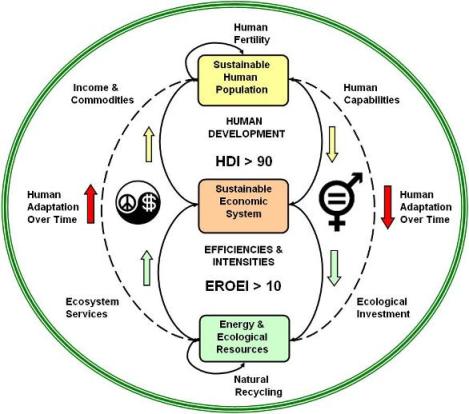
Bounded Population-Economic-Ecological System for Sustainable Human Development
Adapted from
Prosperity without Growth, Tim Jackson, 2011, Figure 12.1, Page 195
BASIC ARCHITECTURE FOR SDSIM 2.0
There are three sets of feedback loops: human development, human adaptation, and industrial mitigation. The human development loops (yellow arrows) improve gender equality and other human capabilities, and guide the allocation of income/commodities generated by the economic system. The human adaptation loops (red arrows) drive ecological investment so as to enhance the sustainability of ecosystem services. The industrial mitigation loops (green arrows) improve the productivity of energy and other resources by using "industrial engineering" methods. The working hypothesis is that mitigation loops are helpful as long as their operation is subservient to, and do not interfere with, the human development and human adaptation loops.
The convergence of gender balance, energy balance, and sustainability emerges from gender imbalance and energy imbalance jointly driving human civilization toward unsustainability. Many other factors are involved, but gender and energy imbalances are the most pervasive, and balancing them would have a neutralizing effect on all the other factors that conspire against a sustainable human society. If the transition from consumerism to sustainability is to be attained in a timely and civilized manner, i.e., before it is too late and minimizing violence as much as possible, balancing gender relations and energy flows would be the best (perhaps the only?) way to go.
INTEGRATED TRANSITION STRATEGY - PHASES VIEW
|
There are four phases: concientization, incentivation, redistribution, and democratization. Phases may overlap recursively. Time is of the esence, but the specifc start/end dates for the time windows are impossible to predict.
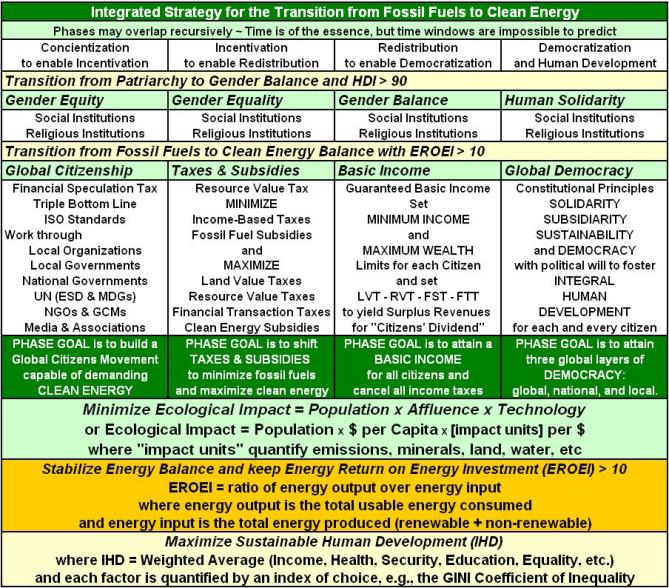
The following acronyms, and terminology are used in this transition concept and subsequent discussion:
Energy Return on Investment (EROI)
Energy return on Energy Investment (EROEI)
Financial Transaction Tax (FTT)
Global Citizens Movement (GCM)
Human Development (HD)
Human Development Index (HDI)
Human Development Report (HDR)
Integral Human Development (IHD)
International Standards Organization (ISO)
|
Land Value Tax (LVT) or Resource Value Tax (RVT)
Maslow's Hierarchy of Human Needs (MASLOW)
Non-Governmental Organization (NGO)
Principle of Solidarity (SOLIDARITY)
Principle of Subsidiarity (SUBSIDIARITY)
Principle of Sustainability (SUSTAINABILITY)
Sustainable Development (SD)
Sustainable Human Development (SHD)
Triple Bottom Line (TBL)
|
The formula I=PxAxT, known as "Ehrlich's Equation," is generally recognized as a good model for the ecological impact of economic activity. The impact is a nonlinear function of human population (P, # of persons), affluence (A) measured as consumption per capita ($/person), and a technology factor (T) that quantifies the impact (in physical units) per dollar of consumption. Note that for impact (I) to decrease, the technology factor (T) must go down faster than the product of population (P) and lifestyle (A) grows.
|
Several formulations are possible for IHD. The best known is the United Nations' Human Development Index (HDI) which includes three components: life expectancy, years of schooling, and GNP per capita. The are many variations of the HDI to include, for example, the gender equality dimension. Other indices attempt to replace GNP with other measures of human wellbeing, such as the Genuine Progress Indicator (GPI), the GINI Cofficient of Inequality, and the Happy Planet Index (HPI).
|
|
The transition entails maximizing human development and wellbeing as much as possible, and minimizing ecological impacts as much as possible, in a manner that leads to economic and ecological stability. Clearly, maximizing human wellbeing and minimizing ecological impact are mutually contradictory goals as long as human wellbeing is measured in terms of material consumption per capita. Since there are resource limits, and there are limits to efficiency improvements via technological innovation, something must give: humans must adapt by shifting expectations of wellbeing from economic affluence to other human development goals. It is impossible to predict how this adaptation process will unfold, but the following synopsis of the transition phases is proposed as a point of reference:
The first phase is concientization to enable incentivation. The objective is to create widespread popular support for the required revisions of tax codes and energy subsidies. In other words, the first phase is about creating a collective mindset of global citizenship and social responsibility, strong enough to translate into political will to face the inevitable transition and implement required reforms. Gender equity is key.
The second phase is incentivation to enable redistribution. The objective is to reform tax codes and energy subsidies to expedite the transition from fossil fuels to clean energy. Applicable reforms include shifting taxes from earned income to the usage (extraction) of unearned resources and the release of pollution, as well as taxing financial transactions of dubious social value. Gender equality is key.
The third phase is redistribution to enable democratization. The objective is to institutionalize democracy with gender balance and distributive justice. This may entail adopting a Universally Guaranteed Personal Income (i.e., a basic minimum income rather than a minimum wage) and a Maximum Allowable Personal Wealth (i.e., an upper limit on financial wealth accumulation) that can be democratically adjusted periodically.
The fourth phase is worldwide democratization. The objective is democratization of global, national, and local governance with deeply ingrained gender balance and widely institutionalized implementation of the solidarity, subsidiarity, and sustainability principles. Decisions are to be made at the lowest possible level consistent with governance capabilities and the common good of humanity.
The four phases are not envisioned to be strictly sequential. They most probably will overlap, with recursions and convulsions along the way. The term "gender equality" is not to be understood as "gender uniformity." By gender equality is meant equality of dignity and personal development opportunities across the entire gender continuum. In other words, full equality in all dimensions of human life: physical, intellectual, psychological, vocational, spiritual. The term "clean energy" is to be understood as "clean renewable energy" that is naturally replenished and does not produce GHG emissions when used. It does not include absurdities such as "clean coal." The combination of gender balance and energy balance is hereby proposed as the necessary and sufficient driver for a civilized (i.e., humane) transition, and are expected to have a multiplying effect throughout the global human system.
INTEGRATED TRANSITION STRATEGY - SYSTEM VIEW
|
SYSTEM VIEW OF THE SUSTAINABILITY PARADOX
The following diagram represents the present world human system:
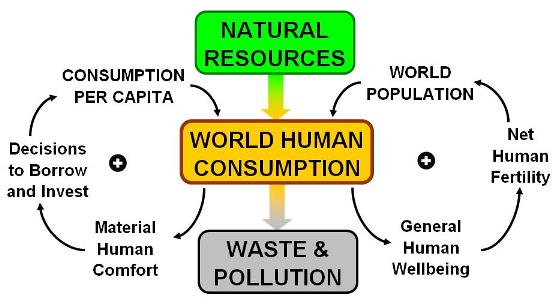
THE SUSTAINABILITY PARADOX
The positive signs indicate positive (self-reinforcing) feedback loops
Based on the Ecocosm Paradox Diagram by Willard R. Fey & Ann C. W. Lam, 1999
The downward flow at the center is the flow (lifecycle) for all kinds of merchandise. The feedback loop on the right-hand side is the population growth process. The feedback loop on the left-hand side is the economic growth process. If human consumption keeps increasing, natural resources are depleted and pollution accumulates. If human consumption decreases/stabilizes, the current economic/financial system destabilizes/collapses. This is the "infinite growth in a finite planet" paradox, which is more commonly referred to as the "sustainable development" paradox or simply the sustainability paradox.
The connecting arrows in the diagram indicate a ceteris paribus direction of influence. In the current world system the sense of every influence is positive, i.e., "more" leads to "more." However, the strength of the influence may change with time depending on various factors. For instance, the strength of the influence from "General Human Wellbeing" to "Net Human Fertility" may decrease after a certain threshold of wellbeing, higher levels of education, and accesibility to reproductive heath care. The strength of the influence from "Material Human Comfort" to "Decisions to Borrow and Invest" may increase when lines of credit with low interest rates are easy to obtain.
SYSTEM VIEW OF THE SUSTAINABILITY PARADOX
WITH SUPERIMPOSED TRENDS
The following diagram represents the present world human system with samples of recent trend data for population, consumption, and the physical flows of energy and materials:
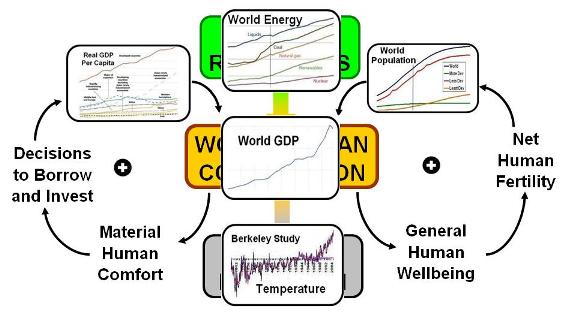
THE SUSTAINABILITY PARADOX WITH SUPERIMPOSED TRENDS
World Population 1950-2100 (UNDATA, 2010 Revision)
World Consumption Per Capita 1965-1995 (World Bank, 2011)
World Human Consumption 1960-2009 (World Bank, 2011)
World Energy Consumption 1990-2035(DOE EIA, IEO 2011)
World Average Land Surface Temperature 1800-2005 (Berkeley Earth, October 2011)
At the moment, the world's population is approximately 7 billion people but the rate of growth is slowing down. Global consumption of goods and services is approaching 60 trillion dollars, with 80% of commodities going to 20% of the population. Empirical data shows that consumption is growing faster than population, even though over one billion people remain in abject poverty. The global financial system is in total disarray. Worldwide, the rich-poor gap is increasing increasingly. Billions of tons of minerals and fossil fuels are being extracted from the earth each year, and billions of tons of waste and pollutants are being dumped back into the environment. Climate change, induced by global warming, is already impacting some human communities. Specific numbers are important, but recent growth patterns and their projected continuation are the main concern. It is impossible to predict the timing of forthcoming events, but it is reasonable to anticipate that infinite material growth in a finite planet is a mathematical impossibility.
The above hypothesis on how economic growth dynamics unfold can be refined in many different ways. For instance, the following diagram includes only the economic growth loops (left portion of the diagram) to show additional investment loops on financial credit, job creation, technology development, and advertising. Now we have a multiplicity of positive feedback loops that reinforce each other and jointly reinforce human consumption, as in the following diagram:
SYSTEM VIEW OF THE SUSTAINABILITY PARADOX
WITH MULTIPLE ECONOMIC GROWTH & JOB CREATION LOOPS
The following diagram represents the present world human system with added detail on job creation in conjunction with the economic growth process:
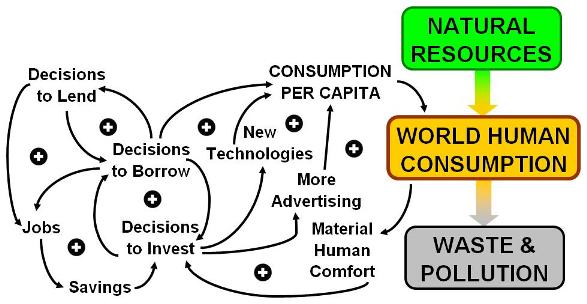
THE SUSTAINABILITY PARADOX WITH MULTIPLE ECONOMIC GROWTH & JOB CREATION LOOPS
Another way to expand the hypothesis is by including the financial growth loops whereby banks lend to industry and, in addition, lend to investors seeking financial gain for the sake of financial gain (i.e., nothing is produced or consumed). Such is the case, for example, when investor A borrows money from bank X at a given interest rate, then lends the money to investor B at a higher interest rate and pockets the additional gain. This kind of financial speculation activity (which is perfectly legal and facilitated by currencies no longer being under the gold or some other tangible resource standard) that may lead to financial bubbles and crises as happened recently in the USA and more recently in Europe. Consider the following diagram:
SYSTEM VIEW OF THE SUSTAINABILITY PARADOX
WITH MULTIPLE FINANCIAL GROWTH LOOPS
The following diagram represents the present world human system with added detail on the financial dimension of the economic growth process:
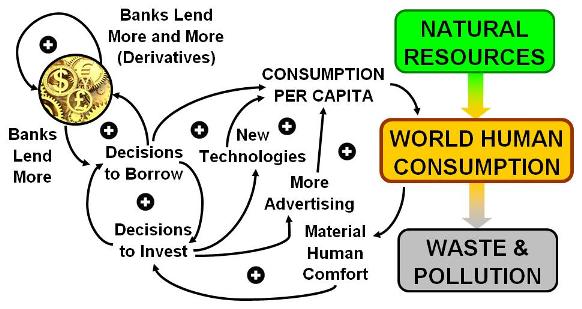
THE SUSTAINABILITY PARADOX WITH MULTIPLE FINANCIAL GROWTH LOOPS
There is empirical evidence that total world population is now increasing decreasingly, so current economic conditions suggest focusing on the economic side of the sustainability paradox. The economic growth process is driven by growing consumer demand for additional material comfort in the form of goods and services. This induces decisions to invest for expansion of industrial capacity, new technologies, and more advertising. Banks reinforce investment by lending to investors, and also by lending to consumers eager to increase their per capita consumption, which is currently growing faster than population. Since the dollar and other currencies are no longer based on gold, banks also can lend for trading in derivatives and other "financial weapons of mass destruction." This unbriddled capital accumulation process, driven by short-term profits and a systematic discounting of the future, assumes that there can be infinite growth in a finite planet, and actually requires continued and unlimited growth to keep functioning. This is the essence of the sustainability paradox.
SYSTEM VIEW OF THE SUSTAINABILITY PARADIGM
The following diagram represents the future world human system:
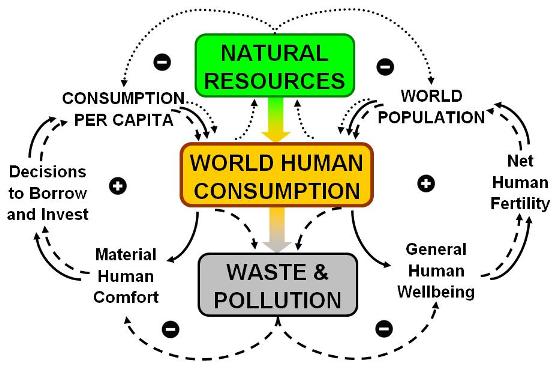
THE SUSTAINABILITY PARADIGM
The positive signs indicate positive (self-reinforcing) feedback loops
The negative signs indicate negative (self-correcting) feedback loops
The new connectors at the top linking natural resources to population and consumption per capita create adaptation loops (dotted lines). As long as natural resources are not limiting, these loops remain inactive. When one or more natural resources (e.g., minerals, water, fossil fuels) become limiting, resource prices are bound to increase and adaptation must take place by limiting population growth, economic growth, or both. On the economic side, this entails reducing consumption, substituting one resource by another, or both.
The new connectors at the bottom linking waste/pollution accumulation to human comfort (material or otherwise) are mitigation loops (dashed lines). As long as environmental degradation does not affect human comfort, these loops remain inactive. When the accumulation of pollutants is such that human well-being (material comfort, health, etc.) is impacted, the costs of environmental remediation are bound to increase and mitigation must take place by shifting priorities from comfort to survival.
SYSTEM VIEW OF THE SUSTAINABILITY PARADIGM
WITH EMBEDDED INPUT-OUTPUT MATRIX
The following diagram represents the future world human system enhanced to show the vector of resource intensities, the matrix of inter-industry transactions, and the vector of emission factors:
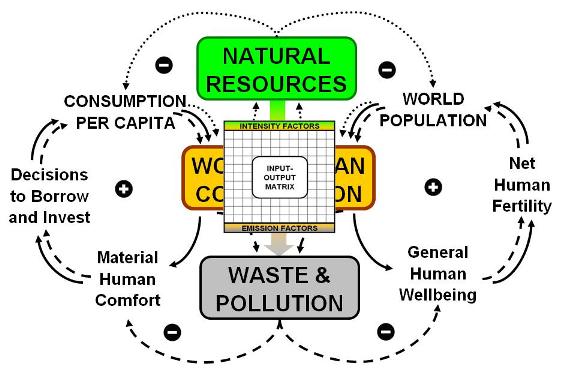
THE SUSTAINABILITY PARADIGM WITH EMBEDDED INPUT-OUTPUT MATRIX
The positive signs indicate positive (self-reinforcing) feedback loops
The negative signs indicate negative (self-correcting) feedback loops
Intensity factors are in resource input units per unit of merchandise produced
The input-output matrix is the Leontief matrix of interindustry transactions
Emission factors are in emission output units per unit of merchandise consumed
When the mitigation and adaptation loops are activated, analysis of possible trade-offs and substitutions will require an embedded inter-industry transactions matrix. How specificity of the analyzable trade-offs will be contingent on the granularity of industry decomposition captured by the input-output matrix. For instance, the North American Industry Classification System (NAICS) divides GDP into 24 major industry sectors which in turn are decomposed into a total of 2228 industries. The web-based Economic Input-Output Life Cycle Assessment (EIO-LCA) at the Green Design Institute, Carnegie Mellon University, divides GDP into 27 "broad sector groups," each further decomposed into a number of "detailed sectors." See also the System of National Accounts (SNA), United Nations, 2009.
SYSTEM VIEW OF THE SUSTAINABILITY PARADIGM WITH PROPOSED
RESOURCE VALUE TAXES (RVT) AND FINANCIAL TRANSACTION TAXES (FTT)
The following diagram represents the future world human system further enhanced to show self-correcting environmental and financial management loops:
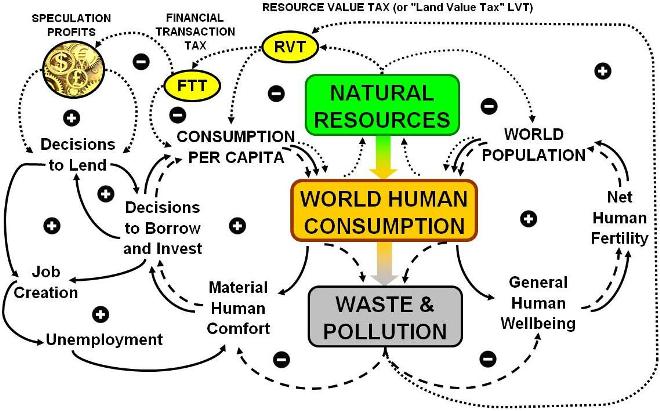
THE SUSTAINABILITY PARADIGM WITH ENVIRONMENTAL & FINANCIAL LOOPS
The positive signs indicate positive (self-reinforcing) feedback loops
The negative signs indicate negative (self-correcting) feedback loops
Resource Value Taxes (RVT) are a function of natural resource depletion/deterioration
Financial Transaction Taxes are a function of RVT and the volume of non-real financial assets
RVT and FTT serve to reinforce job creation and employment opportunities
The formulation of adaptation and mitigation policies will attempt to integrate several dimensions of scientific knowledge and human experience, including gender equality issues, in order to simulate some plausible (but by no means predictive) transition scenarios and trade-offs. For a detailed list of supporting references click here. Nothing is totally unrelated to sustainable human development, and there are many variations of any conceivable transition scenario. Some of the variations to be investigated are identified in the following section.
SDSIM 2.0 ARCHITECTURE
The architecture of SDSIM 2.0 integrates the sustainability paradox into the transition strategy:
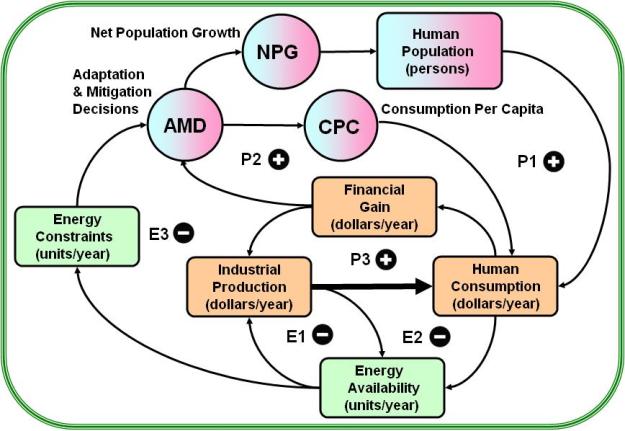
SDSIM 2.0 ARCHITECTURE (WORK IN PROGRESS)
P1, P2, and P3 are the positive population-industrial-financial loops
which currently drive the sustainable development ("infinite growth") paradox
E1, E2, and E3 are negative energy production-consumption and behavioral loops, and
AMD stands for human adaptation-mitigation decisions in response to energy availability constraints
This architecture is proposed as the simplest possible model to capture both the positive (self-reinforcing) feedback loops of the growth paradox and the negative (self-regulating) feedback loops that are bound to emerge during the transition. It is anticipated that dominance will gradually (or not so gradually) shift from the P loops to the E loops as the transition unfolds. The E loops can be generalized to include natural resources other than energy, but energy is the primary concern for SDSIM 2.0. Consideration of other resources, such as water and minerals, is planned for subsequent revisions of the architecture (SDSIM 2.1, 2.2, etc.). AMD is a function of material consumption, financial gain, and energy scarcity and serves to calculate the adaptation and mitigation decisions that are forced by economic and energy constraints. The inverse of AMD is being investigated as a possible model of social cohesion, or the collective capacity to make adaptation and mitigation decisions motivated by human development incentives as opposed to biophysical constraints.
It is critical to take explicitly into account how people and governments will behave in response to changes in the mix of financial profitability and energy availability. What function could be used to model of how people will react to changes in financial profitability and energy scarcity in a given solidarity-sustainability culture? What would be the consequences for population growth (or decline), economic growth (or decline) and quality of life during the transition from consumerism to sustainability? These are the kind of questions to be investigated (via simulation experiments) with SDSIM 2.0. It is understood that social systems are more than closed-loop feedback structures no matter how highly refined the mathematical equations and parameter values. The intent of the SDSIM project is not to provide any final answers but simply to contribute, in some small way, to define more precisely the key questions that must be answered, in a broader context of practicality and wisdom, in order to attain the transition and avoid, to the extent possible, unnecessary human suffering in the process.
SOME PRELIMINARY SIMULATIONS
The current SDSIM 2.0 is a demo, not a capability. For instance, the graph below is a simulation of world population, gross industrial production, average consumption per capita, energy availability, and social cohesion ("solidarity index") trends, during 200 years (1900-2100):
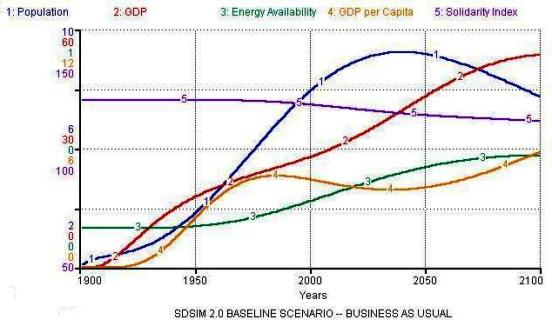
Sustainable Development Simulation (SDSIM 2.0) from 1900 to 2100
|
This simulation suggests that, toward the end of the 21st century, population and social cohesion are declining while GDP and per capita consumption are still rising even as energy availability is peaking. Is this leading to a steady-state economy at high levels of production and consumption? The next graph shows the same system simulated during 1000 years (1900-2900, as shown in the horizontal axis):
SDSIM 2.0 BASELINE SCENARIO
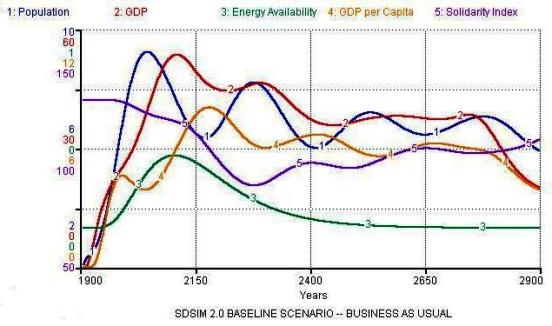
Sustainable Development Simulation (SDSIM 2.0) from 1900 to 2900
|
Due to significant time delays in adjusting population growth and resource consumption rates, and further delays in developing new technologies to "do more with less," the system goes into an extended period of oscillations in population and consumption levels. The amplitude of the oscillations seems to be gradually declining toward new steady-state levels of population and consumption, but at the expense of significant decline in social cohesion (fierce competition over increasingly scarce energy resources?). However, toward the end, drastic adjustments are induced by energy availability returning to the pre-1900 level, i.e., after a very long tail, all fossil fuel resources are finally exhausted.
Extending the simulation for another 1,000 years (next plot), the calculations suggest that another transition would be needed before long-term stability is attained:
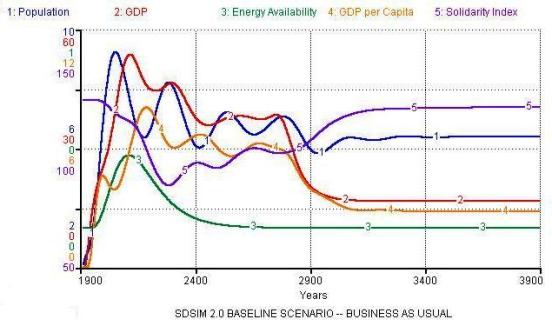
Sustainable Development Simulation (SDSIM 2.0) from 1900 to 3900
|
Beyond 2100, it would seem that the system is leading to steady-state albeit via a long series of oscillations of decreasing amplitude. However, after 2800 or so, energy availability is depleted to just above the 1900 level, or basically solar influx plus of minimum amount of energy from remaining fossil sources. Then, even if massive starvation is avoided by human adaptation, the system adjusts down to a much lower steady-state in terms of population, economic throughput, and "standard of living." Time will tell whether this will make social cohesion decline even further, or eventually induce a much higher level of solidarity (human capacity for virtue out of necessity?) as suggested by the simulation. It cannot be overemphasized that this is a simulation, not a prediction. The simulation simply shows that eventually the system must go back to an energetically sustainable steady-state.
|
SUMMARY OF BASELINE SCENARIO
This is a simulated scenario, not a prediction. It portrays dynamic modes of behavior that can be expected during the transition from consumerism to sustainability. Both simulated time (horizontal axis) and simulated variables (vertical axis) can be adjusted without changing the fundamental patterns of growth, oscillations, and degrowth. During the transition, undoubtedly there will be noise due to short-tem social, economic, and ecological perturbations, but the overall patterns of peaks and valleys will persist in the long-term, as follows:
Population peaking, then oscillating and finally decreasing to a long-term sustainable level. Note time-phasing with GDP and per capita consumption of material goods and services.
The peak in energy availability is followed by a long decline until it settles to the steady-state flow that is allowed by solar (and perhaps other cosmic) sources of energy. The "long-tail" is the result technological developments with gradually decreasing return on energy invested.
The solidarity index is currently formulated as a nonlinear function of human population, material consumption, and energy flows. It is an indicator of social cohesion, which is tightly coupled with the sustainability of resource usage. Solidarity reinforces sustainability and vice versa.
The general patterns of peaks, oscillations, and eventual settling to steady-state are indicative of turbulence during the transition, with high risk of cultural disruptions and violence. The myth of "infinite growth in a finite planet" will not be easy to overcome.
This is not intended to be an "alarmist" scenario. However, it would be wise to take the Precautionary Principle into account when formulation sustainable development policies as we enter the Anthropocene Age.
The past cannot be changed, and the future is unknown. The exact sequence and timing of events cannot be predicted, but the general transitional patterns can be anticipated on the basis of energy biophysics. Specifically, there is empirical evidence to the effect that:
1. Fossil fuel resources are high in energy content but are not infinite.
2. Fossil fuel emissions are environmentally detrimental and/or potentially unsafe.
3. Currently known clean energy alternatives offer relatively low energy content.
Given that fossil fuels are being depleted, pollution levels are damaging the environment, and clean energy alternatives may not provide enough energy to sustain industrial economies, is it wise to just continue doing "business as usual" and trusting that some earthshaking technological breakthrough will come to pass soon enough? Is it fair for people in the "developed" nations to keep indulging in energy consumption and waste while one billion people must subsist on $2 per day or less? How will population growth rate and per capita consumption change in response to impending resource constraints? Will demographic and consumption adjustments be voluntary or involuntary? If they are involuntary, there is a high risk of violence emerging in conjunction with fierce competition for resources throughout the world. Is this "the future we want"?
|
Modeling and simulating the basic variables shown above is not easy but is feasible (as forty years of Limits to Growth analysis has amply demonstrated), and it is self-evident that natural resources (energetic and otherwise) currently being used are not infinite. It is also possible to quantify other physical variables such as polluting emissions, food availability, etc. The big challenge is to formulate mitigation and adaptation decision functions (the AMD node in the architecture diagram) that could reasonably mimic some plausible ways in which human behavior might change as quality of life is impacted and resource scarcities cannot be ignored any longer. Needless to say, the intent is not to be predict but "simply" to analyze, hopefully in a way that yields some useful insight. Easier said than done, as complex financial and cultural factors will come into play.
The Human Development Index, the Environmental Performance Index, the Ecological Footprint, and other such metrics, are useful in the sense that they show the social and ecological impacts of past human decisions. However, they do not take into account how human behavior might change in response to forthcoming dynamics of the transition from consumerism to sustainability. It remains to be seen whether or not such functions can be formulated in a way that is reasonable and useful to enlighten the discussion.
|
INTEGRATION OF SUSTAINABLE DEVELOPMENT AND CLIMATE DYNAMICS
It is becoming increasingly clear that anthropogenic climate changes may be a critical factor forcing human behavior changes during the transition from consumerism to sustainability. A comprehensive model should, therefore, integrate the human and climate systems. In terms of feedback loop structures, the following series of articles may provide a basis for such enhancement of the simulations:
- Why Systems Thinking?, Steve Easterbrook, Serendipity, 20 August 2013.
- The Climate as a System, part 1: the central equilibrium loop, Steve Easterbrook, Serendipity, 22 August 2013.
- The Climate as a System, part 2: energy consumption, Steve Easterbrook, Serendipity, 26 August 2013.
- The Climate as a System, part 3: greenhouse gases, Steve Easterbrook, Serendipity, 27 August 2013.
- The Climate as a System, part 4: earth system feedbacks, Steve Easterbrook, Serendipity, 2 September 2013.
- The Climate as a System, part 5: clouds, Steve Easterbrook, Serendipity, 3 September 2013.
|
|
8. Variations of the Integrated Transition Strategy
|
In terms of the transition from fossil fuels to clean energy, there seems to be a convergence of outlook that is shared by business, agencies, and NGOs. This convergence is reflected in the UN IEA and US EIA scenarios. However, in terms off replacing fossil fuels with clean energy is a post-carbon world, the Paul Chefurka's scenario is the most "pessimistic" and Stuart Staniford's scenario is the most "optimistic." Actually, it is not a matter of being optimistic or pessimistic. The divergence between "best case" and "worst case" scenarios may be due different sets of explicit
assumptions about the timing of supply peaks for non-renewables and ramping up capacities for renewables plus different sets of implicit assumptions about human behavior and policy decisions in the context of an exceedingly complex system. Energy in some form is behind everything that moves, and there are many moving parts in industrial economies.
In their recently published book,
Energy and the Wealth of Nations, Hall and Klitgaard point out that discrediting economic theories that have served us well in the past serves no purpose. It is not a matter of choosing between classical economics, or neoliberal economics, or behavioral economics, or ecological economics, or biophysical economics. But, as they also point out, it is the separation of the biophysical and social dimensions of economics that renders either one useless in confronting newly emerging issues at the intersection of human behavior and physical flows. In every case, however, energy flows are the point of intersection between the behavioral and the physical dimensions, and it could well be that "economic energetics" is the key for integrating both and developing a new synthesis, as proposed long ago by (among others) economist Nicholas Georgescu-Roegen and ecologist Howard T. Odum. In this regard, the "ecological economics" synthesis of Herman Daly deserves especial mention. Hall & Klitgaard's contribution is to isolate energy flows as the focal point for analysis (and hypothesis testing) via the "Energy Return on Investment" (EROI) index.
For the current level of climate change mitigation technologies, it would seem that Staniford's scenario is too optimistic in assuming that the production of fossil fuels can be sustained and the planet can absorb the resulting accumulation of GHG emissions without potentially catastrophic climate disruptions. On the other hand, Chefurka's scenario may be too pessimistic and hopefully will not come pass as the human-impact implications would be severe. EIA's scenario seems to be the most plausible with current technologies and economic conditions. However, the emergence of radically new and economically feasible technologies cannot be ruled out, and there is always the need to plan for the worst case scenario. With this range of scenarios in mind, the following variations are being considered for modeling and analysis:
- Variations in the desired "Quality of Life"
- Variations in the perceived value of human solidarity
- Variations in the perceived value of ecological sustainability
- Variations in the combined value of human solidarity and ecological sustainability
- Variations in the timing and duration of human adaptations
- Variations in the human propensity to consume (volume, choices, fix vs replace
- Variations in the human propensity to adapt (climate, migration, transportation)
- Variations in the pace of progress in secular gender equity, equality, and balance
- Variations in the pace of progress in religious gender equity, equality, and balance
- Variations in the adaptability of the world financial system (speculation, regulation)
- Variations in the resilience of the human habitat (pollution, climate, ecosystem services)
- Variations in fossil fuel reserves and the timing of "peak oil"
- Variations in the timing and intensity of climate changes
- Variations in the performance, schedule, and cost of clean energy technologies
- Variations in the EROI values of non-renewable and renewable energy sources
- Variations in the EROI values for resource discovery
- Variations in the EROI values for resource development
- Variations in the EROI values for resource extraction
- Variations in the EROI values for resource conversion during production
- Variations in the EROI values for resource conversion during consumption
- Variations in the EROI values for resource conversion during disposal
- Variations in the EROI values for resource emissions during production
- Variations in the EROI values for resource emissions during consumption
- Variations in the EROI values for resource emissions during disposal
Given the complexity and nonlinearity of complex ecological-economic systems, computer simulation methods are more promising for the analysis of dynamic modes of behavior related to both the "sustainability paradox" and the "sustainability paradigm" systems are diagrammed above. However, input-output analysis could be very useful to calculate specific interindustry propagations of energy resource substitutions within paradox/paradigm scenarios.
EDITOR'S NOTE: These variations are to be formulated and explored with SDSIM 2.0 (to view SDSIM 1.5, click here).
|
9. Strategic Data Sources & Global Transition Megatrends
|
Listed below are links to the best data and knowledge sources in two categories: strategic data sources and global transition megatrends.
KEY LINKS:
- STRATEGIC DATA SOURCES
- The Ecological Wealth of Nations, Global Footprint Network, 21 December 2010.
- Human Development Report, UNDP, 2011.
- Human Development Index (HDI) Database, UNDP, 2011.
- Policies and Measures Databases, UN International Energy Agency (IEA), 2011.
- Energy Research Guide and Database, US Energy Information Agency (EIA), 2011.
- Energy Outlook 2030, BP, 2011.
- Statistical Review of World Energy 2011, BP, 2011.
- 100% Renewable Energy by 2050, WWF, 2011.
- IMF Financial Databases, IMF, 2011.
- World Income Inequality Database (WIID)
- 2011 World Population Data Sheet, PRB, 2011.
- Gender, Institutions and Development Data Base (GID-DB), OECD, 2011.
- USA Federal Government Databases (DATA), US Government, 2011.
- United Nations Database (UNData), United Nations, 2011.
- International Energy Outlook 2011, US DOE/EIA, September 2011.
- World Energy Insight 2011, World Energy Council, September 2011.
- Global Megatrends Factsheet, German Advisory Council on Global Change (WBGU), October 2011.
- World Energy Outlook 2011, IEA, 9 November 2011.
- IEA sees a world run on solar, Giles Parkinson, Climate Spectator, 6 December 2011.
- Oil Market Report, IEA, 13 December 2011.
- Ireland plots path to a sustainable energy future, IEA/SEAI, 22 December 2011.
- 2012 World Population Data Sheet, Population Reference Bureau (PRB), March 2012.
- State of the World 2012: Moving Toward Sustainable Prosperity, Worldwatch Institute, April 2012.
- Vital Signs 2012: The Trends that are Shaping our Future, Worldwatch Institute, April 2012.
- Handbook on Climate Change, Human Security and Violent Conflict - Challenges for Societal Stability, Jürgen Scheffran, Michael Brzoska, Hans Günter Brauch, Peter Michael Link, Janpeter Schilling (Eds.), Hexagon Series on Human and Environmental Security and Peace, vol. 8 (Heidelberg - Dordrecht - London - New York: Springer, 30 April 2012).
- When will Oil, Natural Gas, and Coal Peak?, G. Maggio & G. Cacciola, Fuel, August 2012.
- Oil - The Next Revolution: The Unprecedented Upsurge of Oil Production Capacity and What It Means for the World, Leonardo Maugeri, Belfer Center, Harvard University, June 2012.
- Global Energy Assessment (GEA), IIASA, September 2012.
- Peak oil isn’t dead; it just smells that way, Chris Nelder, Smart Planet, 24 July 2013.
- World Energy Use to Rise by 56 Percent, Driven by Growth in the Developing World, U.S. Energy Information Administration, 25 July 2013.
- Annual Energy Outlook 2014, U.S. Energy Information Administration, 30 April 2014.
- GLOBAL TRANSITION MEGATRENDS
|
|
|Back to the SUMMARY|
|Back to SECTION 1|
|Back to SECTION 2|
|Back to SECTION 3|
|Back to SECTION 4|
|Back to SECTION 5|
|Back to SECTION 6|
|Back to SECTION 7|
|Back to SECTION 8|
|Back to SECTION 9|
Page 1
Page 2
Page 3
Page 4
Page 5
Page 6
Page 7
Page 8
Page 9
Supplement 1
Supplement 2
Supplement 3
Supplement 4
Supplement 5
Supplement 6
PelicanWeb Home Page
|
|
"Custom without truth is the antiquity of error.
Let us forsake the error and follow the truth."
St. Cyprian, Epistle 73, 3rd Century CE
|
|
Supplement 3
|
|
FREE SUBSCRIPTION
|
![[groups_small]](groups_small.gif)
|
Subscribe to the
Mother Pelican Journal
via the Solidarity-Sustainability Group
Enter your email address:
|
|
|
|